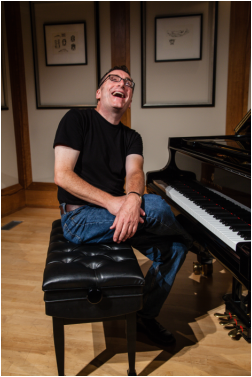|
It’s a bold claim, and intentionally provocative to be sure. But let’s explore the claim in the context of the potential of live online music lessons. In much current thinking, the online lesson is a compromise—a simulation of the face to face lesson that lacks personal contact and effective interpersonal communication. However, research of live online lesson delivery as well as anecdotal evidence from active online teachers’ experiences, shows that the live online paradigm presents opportunities for a better learning experience, and indeed may soon be the “110% solution.” Because we’re talking about a new paradigm and medium of delivery, the notion of “better” encompasses a number of aspects, both practical and experiential. The practical points include: +Scheduling flexibility free from travel +Saving time and money +Learning/teaching at home +Learning or teaching while away from home, on vacation or traveling +Time-zone shifting—filling teaching schedules in hours that are “down” locally +Retaining favorite students/teachers who move away +Ability to have quick coachings, audition run-throughs, competition evaluations +No germs from sick teacher or student who otherwise feel well enough to have a productive lesson The experiential opportunities are where even more promise lies. Consider the following: +A study* published in The American Journal of Distance Education in 2010 compared live online lessons with traditional in-person lessons. The following findings are noteworthy: “When on-line lessons were compared to face to face lessons, there was a 28% increase in student playing, a 36% decrease in off-task comments by the instructor, a 28% decrease in teacher playing (modeling), and an increase in student eye contact. In the online lessons, less than 3% of the time was spent on technology issues, although audio and video quality concerns were mentioned.” +In online lessons we can look at and listen to our students from a variety of angles with distributed webcams, recorded video, MIDI transmitted over the Internet, and video analysis tools. As new technology continues to be developed, we have tools for objective analysis of accuracy of notes and rhythm, allowing us to focus on technical issues and bringing forth richly communicative musical performances. Think of major-league sports. If we were learning the techniques and details of football, for example, viewing the modern enhanced television broadcast with digital replay, multiple camera angles, analysis and commentary would certainly instruct us far more quickly than sitting in the stands at a game. (Obviously, if the goal were to play football, we’d have to get out there and do it! Online lessons offer both—the enhanced learning experience as well as the doing.) And with regard to the practical side of “better”—we can experience far more football on the television than we can in the stands, if we consider cost, travel, weather… Sure, there’s no replacing the excitement of being in the stands with the screaming crowd just as there’s no replacing the wonderful experience of music live in a room, but the path to learning is greatly enhanced by a media-rich experience when used well. +Online lessons allow us to explore a variety of length and frequency of lessons unencumbered by a traditional once-per-week scenario, that in part is an adaptation to the reality of traveling to the teacher’s (or student’s) home or studio. If the feedback loop between teacher and student is more frequent, perhaps shorter periods of time, might a student learn better? How many times have we lamented the bad habits developed in a week of practice, or sought to fill the 30 or 60 minute time slot for an unprepared student? Why not teach by the minute and meet the student multiple shorter times per week? In my college studio, I had an open door policy most days when I wasn’t scheduled in lessons or coachings or otherwise requiring uninterrupted time. Students would drop in regularly, asking questions or playing through pieces or passages for mid-week feedback and guidance. This regular feedback and interaction I found to be very effective for keeping the students on track and actively engaged in their work, almost as if they were involved in the daily intensity of a summer camp or festival—experiences that we know are invigorating and launch great progress in short periods of time. +Anecdotally, I’ve talked with a number of teachers who find that young students, and especially those with attention challenges, are taught more effectively online than in person. Children have the ability to focus intently on the computer screen (sometimes much to the parents' chagrin!), and with only the teacher’s hands or face and instrument, the distractions tend to vanish. While many challenges remain for the dream of the “110% solution,” the path to this ideal is mostly one of technical solutions. Technical solutions can and will be found. Reliable audio and video, rich musical performance analysis tools, kinesthetic analysis, enhanced recall tools, new ways of sharing and interacting with published content (scores and recordings,)—all these solutions have many busy technologists working vigorously to make them reality. What are your experiences with and thoughts about online lessons? *Orman, E. K. and Whitaker, J. A. (2010). Time usage during face-to-face and synchronous distance music lessons. American Journal of Distance Education, 24(2), 92-103. About the Author: Pianist, recording artist, educator and entrepreneur—Philip Amalong is VP of Community and Content and co-founder of the ZOEN (Zenph Online Education Network).
0 Comments
Your comment will be posted after it is approved.
Leave a Reply. |
AuthorObserver of the world of music, performance, learning and technology. Performer, Producer, Recording Artist, VP Community and Content-Zenph Inc. Categories
All
Archives
January 2013
|
Philip Amalong | Pianist, Recording Artist, Educator, VP-The ZOEN

 RSS Feed
RSS Feed

